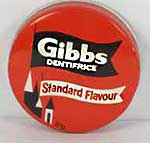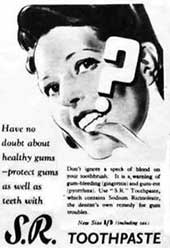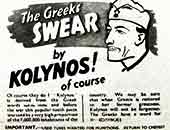

Dental care mid-20th Century UK
By the 1940s, there was an improvement over early 1900s dental care, but it was still unpleasant.
The school dental surgery
The school dental surgery was inside a school clinic when I was at school in the 1940s. It served a number of schools in the area.
The dentist at school
An early visit to the dentist for me was when a dentist set up in a room at my school. Everyone was seen and I can remember waiting my turn and seriously thinking of running away, but when I thought more about it I realised that I would eventually have to return home and get told off. When it was my turn the dentist decided to drill away for quite a time. It was all very painful and wasn't helped by the dentist threatening me that if I didn't remain quiet and still he would call in my class to watch!
Neil Cryer
The dental centre
I have memories of my father taking me to some dental centre and can vividly remember him saying if we walked a bit faster we could get in ahead of that person over there who was clearly heading to the same place. My only thought was not to hurry, I would much rather delay and put off the whole event.
Neil Cryer
Dentistry at home
On my daily walk to school there was a large house where one day I noticed a dentists chair and equipment had been set up in a room at the front that I could see into. It was only there for a day. On commenting to my parents I was told that some wealthy people had the dentist visit them.
Neil Cryer
Tooth fillings: black, gold and white
I had to have a lot of fillings in my teeth in the 1940s. It was a dreadful experience. This was because the drill was much slower than today's drills and there were no injections. It hurt dreadfully and the only way that the staff had to deal with complaints about the pain was to laugh them off and say what a baby one was.
The fillings were black. There was no option.
Gold teeth and fillings
I did see older people with gold fillings as late as the 1960s. They had had their dentistry work done before suitable man-made materials had been developed. Their back teeth which didn't normally show were filled with the standard black mercury amalgam. Only the visible front teeth were filled with gold. Gold does not tarnish or react with any other substance, so in some ways it was suitable. However, gold is soft, so its use in dentistry must have been limited. Also gold was and is expensive.
A gold tooth was not a decoration or jewellery, it was functional, but it was also a status symbol because ordinary people either couldn't or wouldn't afford it. Instead, their bad teeth were simple pulled out, and it was quite normal to see people with gaps in their teeth where one or more teeth were missing.
I can't remember when I last saw anyone with a gold tooth, probably due to improvements in dentistry and the free NHS.
Tooth extractions
I had what I seem to remember as quite a lot of tooth extractions at the school clinic. This must have been from my milk teeth as I have a full set of teeth as an adult.
Tooth extractions were always painless because we were 'put out' for them, i.e. made unconscious. The general anaesthetic was gas, using a mask over the mouth and nose. I always felt surprisingly cheerful when I woke up and I wonder now if the gas was nitrous oxide, laughing gas. I don't suppose that we were under very long because pulling a tooth is quite quick.
Teeth straightening
Due to falling out of my pram as a baby and knocking out my front baby teeth, my adult teeth started growing crooked. The school dental surgery took this in hand and fitted me with a brace. It was uncomfortable, embarrassing and affected my speech. However, for all my adult life my teeth have been straight as a result, and I am extremely grateful to the school dentist for fitting that brace. After all, the problem was only cosmetic, not life threatening. Looking back, now, I am surprised that it was done, but I suppose by then it was on the NHS.
The stress on needing to clean teeth at home
Visits to the dentist always included the instruction to clean one's teeth night and morning.
Toothbrushes
Toothbrushes were bristle set in a straight wooden handle.
Cake-style toothpaste in a tin
For cleaning our teeth, we had a solid pink 'cake' of substance in a red, green or blue tin - our choice of colour. There was no difference in the contents, so the colour was probably just so that individuals in a family knew which tin was theirs.
The toothpaste was known as Gibbs Dentifrice. We rubbed a wet toothbrush into it to make it froth, then used the frothy toothbrush to brush and our teeth. Then we rinsed out with water. Teeth certainly felt clean afterwards.

Tin of Gibb's Dentifrice toothpaste - a solid pink 'cake' in either a red, green or blue tin
People weren't as concerned about germs in those days, so probably all the children in some families rubbed their toothbrushes over the same 'cake'. It wasn't long though before Gibbs Dentifrice was removed from sale, probably around the 1950s.
Dental floss
I never heard of dental floss, although the occasional use of a length of cotton thread came in handy at times.
Cream-style toothpaste in a tube
After the 'cake' style toothpaste we graduated to toothpaste in a tube, but the tube of course was metal not plastic. When squeezed, it folded into tight ridges that couldn't be smoothed out and sometimes cracked so that the contents oozed out. The best way of getting all the toothpaste out was to roll the tube up to its end. Once rolled, being metal, unlike plastic, it stayed in position.

Typical old toothpaste tube made of metal, showing the creases in the tube and how the end had to be rolled up to squeeze out the contents. These tubes often split through so much squeezing, letting the contents ooze out.
Common toothpaste brands

Advert for SR toothpaste in a 1943 magazine

Advert for Kolynos toothpaste in a 1943 magazine
Both adverts photographed in Dinefwr Park House
All the toothpastes shown in the adverts were household names.
Dentures
I can remember my father being very anxious indeed and was told by my mother that he was going to the dentist to have ALL his teeth out.
When he came back home, he had dentures which he had to keep in his mouth and not take out for any purpose for a considerable time, so that the gums would heal to fit the dentures. I can't remember for how long but I guess it must have been for at least a couple of weeks.
A major problem with a complete replacement of teeth by denture was keeping the dentures in while chewing. I don't know how they did it but wonder whether they had some sort of sticky stuff that held them in place.
At least the false teeth were white!
Neil Cryer
There is a page on dental care earlier in the century.
If you can add anything to this page or provide a photo, I would be pleased if you would contact me.
sources: early 20th century material
sources: ww2 home front and other material
contact
the webmaster/author/researcher/editor
privacy policy
















